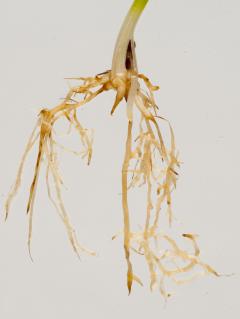Growers are urged to diagnose what is causing patches or uneven growth in their crops
- Cadoux
- Yerecoin
- Tammin
- Brookton
David Stead (Anasazi Agronomy) reports that he is seeing distinct patches in cereal crops right across his advisory district (shires within Cadoux to Yerecoin and Tammin to Brookton) that he strongly suspects are caused by rhizoctonia root rot. The cereal plants in this area are generally at end of tillering. Paddocks with a history of rhizoctonia that had Uniform® or a similar in-furrow fungicide registered for control of the pathogen are noticeably less patchy. Dry conditions are exacerbating the patchiness of infected paddocks.
Growers are urged to identify the causal agent/s of any cereal crops with patching or uneven growth.
Distinct patches are often evident when the primary roots of plants are infected early, while infection of the crown roots later in the season may cause an uneven crop. It is important to know that patches are not unique to rhizoctonia. There are other diseases including root lesion nematodes (RLN) and take-all as well as non-disease issues that can cause them. In particular, patches caused by rhizoctonia or RLN are difficult to distinguish without close inspection of the plant roots and often require further laboratory tests to isolate rhizoctonia or extract any nematodes.

There is nothing that can be done in season to control root diseases. An application of nitrogen post-sowing may aid recovery, but does not prevent root damage. Plant pathologist Daniel Huberli says that before the next crop is planted, it is important that the disease or issue causing the patches is confirmed in order to put the right management plan in place for 2018.
For diagnosis of root disease or nematode problems in-crop, carefully dig up symptomatic plants from the edge of the patch (not the centre) as well as healthy plants from outside the patches. The department’s YouTube video How to take a plant sample shows the correct method to use. Plants can be sent to the department’s Diagnostic Laboratory Services, Department of Primary Industries and Development, Western Australia, Reply Paid 83377, 3 Baron-Hay Court, South Perth WA 6151.
Keeping disease inoculum levels at low levels is the most effective way to minimise crop losses from root diseases and this can be achieved by thinking long-term and implementing management practices over more than one cropping season.
If you have confirmed your paddock has rhizoctonia with large amounts of the crop affected this year, the best option would be to place the paddock into a grass-free break crop in 2018, such as canola, pulse or pasture. Canola has been shown to reduce the level of disease in the following cereal crop.
For detailed information about management options for rhizoctonia read the GRDC's Tips and Tactics Rhizoctonia factsheet.
For more information and pictures of disease symptoms refer to the department’s;
- Diagnosing rhizoctonia root rot in cereals page
- Root disease under intensive cereal production systems page
- Rhizoctonia in your paddocks YouTube video.
For more information contact Daniel Hüberli, Plant Pathologist, South Perth on +61 (0)8 9368 3836.


